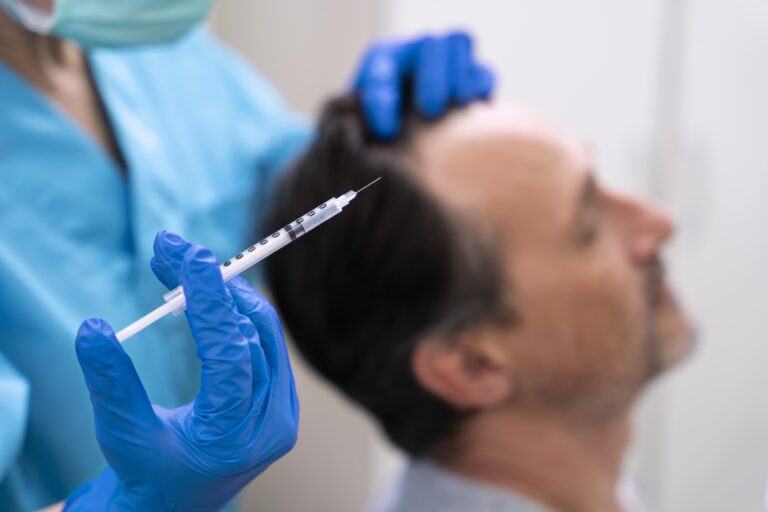
Hair loss is a common issue that affects millions of people worldwide, regardless of age or gender. Whether it’s due to genetics, stress, hormonal imbalances, or medical conditions, thinning hair can take a toll on self-confidence.
Fortunately, modern advancements in hair restoration have introduced effective non-surgical treatments, and PRP (Platelet-Rich Plasma) therapy is one of the most promising options. In this blog, we’ll dive into what PRP therapy is, how it works, its benefits, and whether it’s the right solution for you.
PRP, or Platelet-Rich Plasma therapy, is a cutting-edge treatment that utilizes the body’s natural healing abilities to stimulate hair growth. The process involves using the patient’s own blood, which is rich in platelets and growth factors, to rejuvenate the scalp and activate dormant hair follicles.
Here’s how it works:
The growth factors in PRP promote cell regeneration, improve blood supply to the hair follicles, and encourage natural hair growth over time.
The science behind PRP therapy lies in the regenerative properties of platelets. Platelets are a component of blood that plays a critical role in healing injuries by releasing growth factors.
When PRP is injected into the scalp:
PRP therapy has gained immense popularity due to its multiple benefits:
While PRP is effective for many people, it may not be suitable for everyone. You’re a good candidate if:
However, PRP may not be effective for:
A consultation with a specialist is essential to determine if PRP is right for you.
The PRP therapy process is straightforward and usually involves the following steps:
The procedure is generally well-tolerated, with most patients describing the injections as mildly uncomfortable.
PRP therapy requires little to no downtime. Here are a few aftercare tips:
Mild redness, tenderness, or swelling is normal and typically resolves within a day or two.
Hair growth takes time, and results from PRP therapy are not instant. Here’s what to expect:
To maintain results, follow-up sessions may be recommended every 6–12 months.
PRP offers a unique, non-invasive solution for hair restoration that aligns with your body’s natural processes. Unlike surgical options, PRP is safe, quick, and requires no extended recovery. It’s particularly appealing to those seeking a natural approach to combating hair loss.
Choosing a reputable clinic is crucial for the success of your PRP treatment. Look for:
Hair loss can feel discouraging, but PRP therapy offers a promising, natural solution to help you regain confidence and achieve healthier, fuller hair.
If you’re ready to explore PRP therapy, consult with a trusted specialist to discuss your needs and goals. With PRP, you’re one step closer to restoring your hair—and your confidence.
Contact us today to book your consultation and begin your journey to hair restoration!
PRP (Platelet-Rich Plasma) therapy involves using your blood’s natural healing components to stimulate hair growth. Platelets, rich in growth factors, are injected into the scalp to awaken dormant hair follicles, enhance blood flow, and promote natural regrowth.
Most patients require 3–4 initial sessions spaced 4–6 weeks apart. Maintenance treatments are typically recommended every 6–12 months for long-lasting results.
The procedure is generally well-tolerated. While some patients report mild discomfort during the injections, numbing creams can be applied to minimize pain.
PRP is ideal for individuals experiencing early-stage hair loss or thinning due to androgenic alopecia (male or female pattern baldness). It’s less effective for those with severe or complete hair loss.
PRP is a safe treatment with minimal side effects since it uses your own blood. Mild redness, swelling, or tenderness at the injection site is common but resolves within a day or two.
Hair loss is a common issue that affects millions of people worldwide, regardless of age or gender. Whether it’s due
Living with allergies can feel like an endless struggle. For some, it’s a seasonal inconvenience—sneezing, watery eyes, and nasal congestion
Taking care of your skin is essential not only for your appearance but also for your overall health. Whether you're
Preventive care plays a critical role in maintaining long-term health. Among the tools available for early disease detection, radiology stands
In the modern workplace, desk jobs are a staple, with many employees spending long hours in front of screens. While
Winter in Dubai is a refreshing time of year, offering cooler temperatures and countless opportunities to focus on wellness. Whether
For women, health challenges often revolve around hormonal balance, menstrual cycles, and fertility. Traditional therapies like Hijama (wet cupping) offer
As parents in Dubai, ensuring your child's health and well-being is always a top priority. The fast-paced lifestyle, combined with
Home Basic Skincare Tips: How to Create the Perfect Routine for Your Skin Type November 19, 2024 Your skin is
Undergoing surgery is a major event, and proper post-surgery care is essential to ensure a smooth and speedy recovery. Whether
World Iodine Deficiency Day, observed on October 21, aims to raise global awareness about iodine deficiency and its impact on
Home World Osteoporosis Day: Understanding and Preventing Osteoporosis October 20, 2024 World Osteoporosis Day, observed on October 20th, is a
October is Breast Cancer Awareness Month, a critical time to raise awareness about the importance of early detection and timely
Home 10 Reasons Why Regular Health Checkups Are Important October 19, 2024 Your Health, Our Priority Regular health checkups are
Home World Pediatric Bone and Joint Day: Focusing on Pediatric Bone and Joint Health October 18, 2024 Observed on October
Home What to Do When Your Teeth Hurt From Eating Sweets October 5, 2024 Do your teeth hurt when you
Home Abdominal Pain – Causes, Diagnosis & Treatment September 26, 2024 Abdominal pain is a common symptom that affects people
WhatsApp us